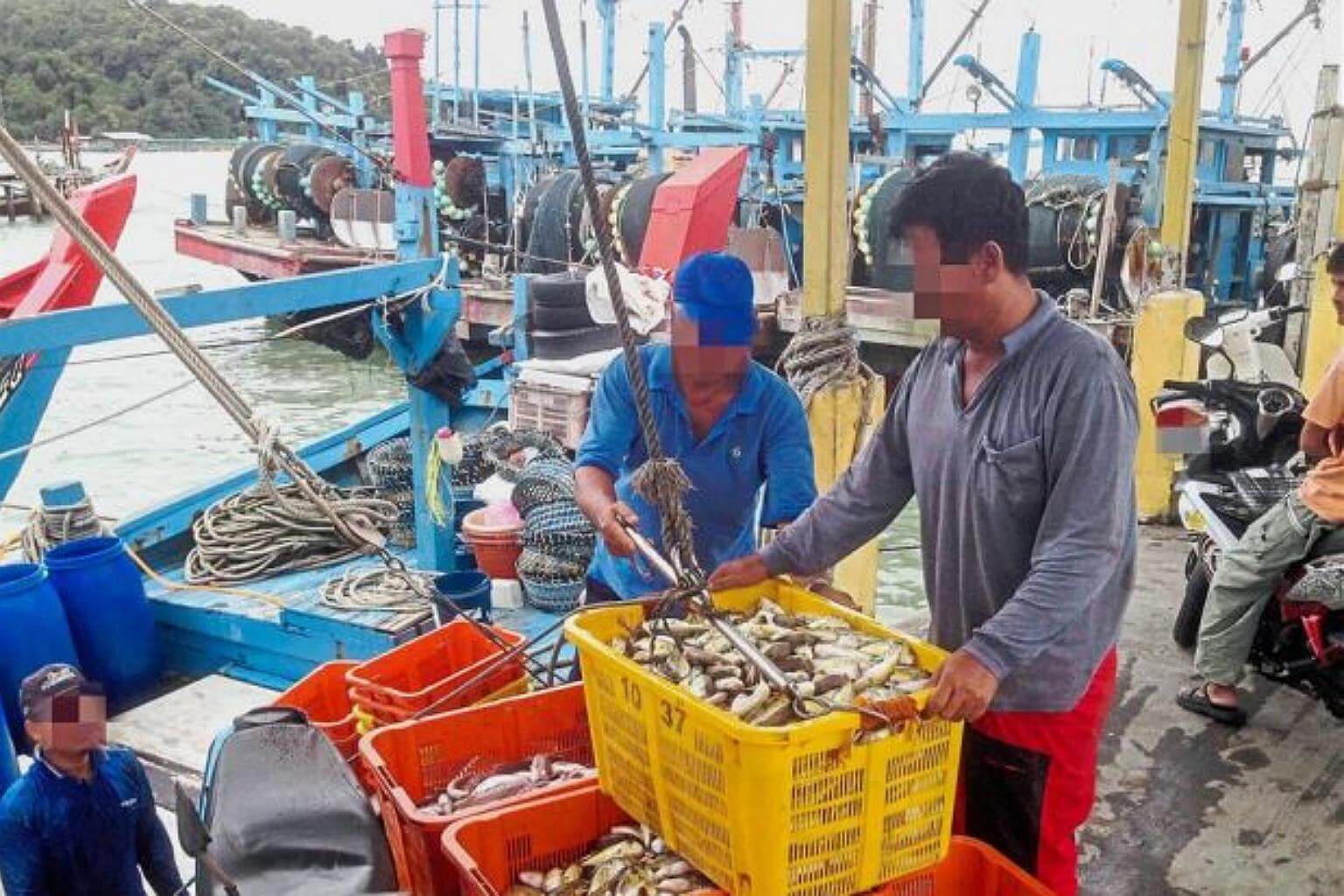Malaysia to make sale of pufferfish illegal after wet markets found selling them without proper gutting
Sign up now: Get ST's newsletters delivered to your inbox

Workers unloading baskets of pufferfish at Teluk Bahang jetty.
PHOTO: THE STAR/ASIA NEWS NETWORK
Follow topic:
PETALING JAYA (THE STAR/ ASIA NEWS NETWORK) - Malaysia's Health Ministry is coming up with a regulation to make the sale of pufferfish illegal unless its toxins have been removed first after several wet markets in the country were found to be selling the poisonous fish without proper gutting.
Pufferfish are known to be poisonous to humans as they contain tetrodotoxin, a substance toxic enough to kill a person in a few hours when ingested in amounts of as little as 25mg.
The Star, in an exclusive report, found that filleted pufferfish were being sold widely in wet markets in Penang, Kedah and Perak at RM18 (S$5.77) to RM20 per kg, under the guise of "crystal fish".
According to the paper, eateries are also buying crystal fish, as its white-coloured flesh makes it an acceptable substitute to costlier species at a substantially lower price.
The Health Ministry said amendments to the Food Act 1983 would forbid the import, preparation, advertisement or sale of pufferfish unless it is made safe first by "qualified persons".
And anyone found guilty of the offence would be fined RM10,000 (S$3,207), or two years' imprisonment.
Health director-general Noor Hisham Abdullah said the new law, through regulations governed by the Food Act, was being finalised for gazettement.
The amendments were first proposed in 2014 when the ministry sought public opinion on the proposals.
Known as fugu in Japan, the fish is considered a delicacy but its sale in markets and restaurants there is highly regulated.
There is no known antidote to tetrodotoxin, which is considered even deadlier to humans than cyanide.
But the fish is not completely inedible. The trick is knowing where the poisonous parts are - typically the liver, eyes, eggs, blood and skin - and skilfully removing them without contaminating the rest of the fish with toxin.
However, unlike Japan, where licences are issued to expert chefs after a tough exam and apprenticeship, Malaysia has no organisation that regulates those who wish to prepare pufferfish for consumption.
In Japan, chefs are required to undergo two to three years of internship before they are qualified to serve the dish, usually in the form of sashimi (raw) or chirinabae (hot pot with vegetables).
The chef also has to display his licence before he can ply his trade.
THRIVING BUSINESS
Those measures are not being carried out at the fish markets where they are sold in Malaysia.
A source told The Star that foreign labourers with little experience in gutting the fish were employed to slice the pufferfish, known locally as buntal pisang.
"These labourers were told to just slice the tail portion of the pufferfish, below its abdomen, missing out the stomach. Gutting activities are carried out in makeshift huts and backyard operations near the ports where these fish were unloaded," he said.
The worrying thing is that selling pufferfish fillet is becoming a thriving business. At least four fishing trawler operators in Penang and two in Kedah are involved in netting and supplying pufferfish fillet commercially, said the source.
"It is a booming business in the northern states as there is a big demand for such fillets by unsuspecting buyers," said the source.
NO LAW TO PREVENT ANYONE FROM SELLING
A Fisheries Department official said there is currently no law to prevent anyone from selling pufferfish.
"Pufferfish is considered 'trash fish' (no commercial value) by the department. It has never been fished commercially nor has its meat been sold in the market," said the official, who added that in the past, pufferfish would just be thrown back into the sea when caught.
The risk to consumers comes not from the fish itself but on how it is prepared for consumption, said fisheries expert Dr Mohd Azmi Ambak.
He said that a slip while gutting the fish could rupture the toxic internal organs and taint the fillet.
Tetrodotoxin is not to be trifled with as it is colourless, tasteless, odourless and cannot be destroyed by cooking in high heat.
"The fish itself does not produce the poison. The poison is produced by bacteria living inside the fish in a symbiotic relationship," said the senior professor who lectures at Universiti Malaysia Terengganu's Faculty of Fisheries and Aqua-Industry.
Dr Mohd Azmi said eating pufferfish is a dangerous act, considering that one pufferfish contains enough tetrodotoxin to kill at least 30 people.
"There is a huge risk involved when consuming it, considering the poison it carries," he said.
According to Universiti Malaysia Sarawak's (Unimas) Assoc Prof Dr Samsur Mohamad, symptoms can be seen within minutes after consuming the poison.
"For the majority of cases, symptoms such as numbness in the mouth, lips and tongue occur within 30 minutes to three hours from intake and after that, the victim begins to experience headaches, nausea and even vomiting," said Dr Samsur.
The rest of the body slowly becomes paralysed, causing death when the heart and lung muscles are also paralysed. However, the victim's brain is not affected, and is aware of what's happening.
There are 32 species of pufferfish in the country, with the Sarawak yellow puffer being the most consumed by locals.
According to papers authored by researchers from Unimas' Faculty of Resources Science and Technology, the Sarawak yellow puffer is the least toxic among local species.
However, despite the low toxicity level, there are still reports of people getting mild neurotoxin poisoning after eating the fish.
From 1985 to 2014, the ministry's Disease Control Division recorded 55 cases of pufferfish poisoning and 17 tetrodotoxin-related deaths.
The Health Ministry's Dr Noor Hisham said that the ministry would continuously educate consumers on food safety, including the dangers of eating pufferfish.
"Consumers are advised to be careful when eating pufferfish as it can cause death."

